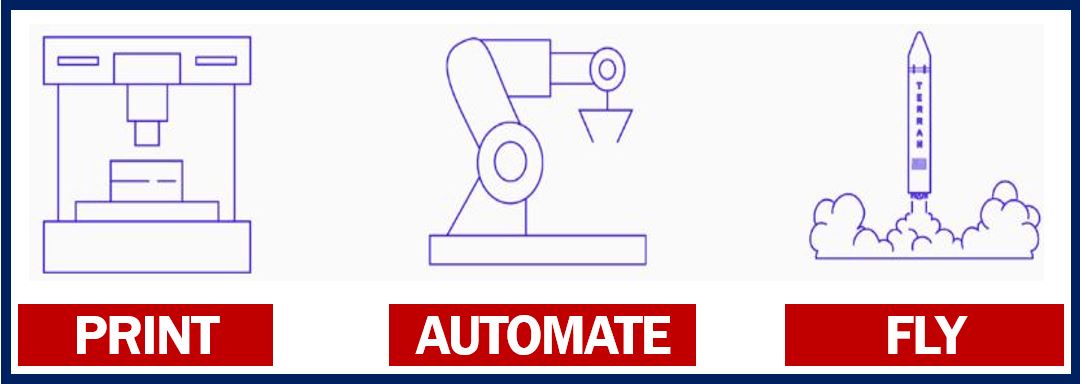
Relativity Space says it is revolutionizing the rocket manufacturing industry. (Image: adapted from realitivyspace.com)
Relativity Space, a 3D printing startup aerospace company that can make a rocket in sixty days, now has its own launch pad at Cape Canaveral. Cape Canaveral Air Force Station, the busiest spaceport in America, will soon see 3D-printed rockets lifting off into space. A startup is a young company that entrepreneurs have set up and often attracts the attention of venture capitalists and large corporations.
Relativity Space (Relativity), based in Los Angeles, California, was founded by Jordan Noone and Tim Ellis in 2015. Noone and Ellis were two defectors from SpaceX and Blue Origin (respectively)
Relativity’s launch pad – LC-16 – was once used by the American military to launch Pershing and Titan ballistic missiles. Since the late 1980s, however, LC-16 has been inactive.
Relativity can make a rocket in days
It takes years to build a rocket that flies into space. Relativity says that with its 3D-printing technology, it can build one in a matter of days. It has the first autonomous platform to build the future of humanity in space and other planets.
It is the first company or organization to create an autonomous rocket factory plus launch service.
According to the company’s website:
“We are an orbital launch company that will deploy and resupply satellite constellations with industry-defining lead time and cost. Our entirely new process to build and fly rockets will redefine how we access space to connect our planet.”
Its long-term goal is to 3D-print the first rocket made on the Red Planet (Mars).
Relativity – a new way to build
The company is creating the rocket factory of tomorrow:
– The factory makes 100% 3D-printed rockets.
– It is the first fixed tooling-free, evolvable factory.
– A 3D-printer the size of a building – Stargate – makes the rockets.
– It is a process that uses state-of-the-art hardware plus software.
– The whole manufacturing system is robotically automated.
Video – 3D Printing
According to Relativity:
“Complete printing of our rocket, Terran 1, reduces vehicle part count from nearly 100,000 to under 1,000 components – and is the first step toward an entirely autonomous factory.”
Accelerating the design process
Relativity is accelerating the design process by getting rid of the barriers that exist between the physical and digital worlds.
Aeon 1 – the rocket engine
Engineers designed the Aeon 1 rocket engine to create 15,500 of thrust, i.e., 68975 newtons of force, at sea level. In a vacuum, it will have 19,500 pounds of thrust (86,775 newtons).
The engine’s fuel is liquid methane and liquid oxygen (LOX). The 3D-printed rocket engine only has about 100 parts.
(Left) Terran 1 – the launch vehicle. (Right) Aeon 1 – the engine. (Images adapted from relativity space)
Terran 1 – the launch vehicle
With 3D-printing, Relativity created Terran 1 from fewer than 1,000 components. Most rocket makers need nearly 100,000 components.
Terran 1 is an expendable launch vehicle. It will consist of two stages:
– The first stage will use nine Aeon 1 engines.
– The second stage will use just one Aeon 1 engine.
It has a maximum payload of 2,760 lb (1,250 kg) to 115 miles (185 km) low Earth orbit. Rather than helium for pressure, it will use autogenous pressurization.
Stargate – the 3D printer
Relativity says that Stargate is the backbone of its vertically integrated factory. It can create a rocket that flies into space using raw materials in less than sixty days.
According to Relativity:
“Stargate is constantly getting smarter and faster by using sensors and reward function-based learning. We are creating an entirely new type of evolvable production line.”
Stargate is the world’s biggest 3D printer of metals. (Image: adapted from realitivyspace.com)
What is 3D printing?
3D printing technology uses a 3D printer to create three-dimensional objects. 3D printing is a type of additive manufacturing. With additive manufacturing, you start with nothing, add layer after layer, until you complete the finished product.
It contrasts with subtractive manufacturing, which works the other way round. Subtractive manufacturing starts with, for example, a block of wood, and keeps chipping away at it until the product is completed.
With 3D printing and additive manufacturing, you keep adding layer after layer. With subtractive manufacturing, you keep removing (subtracting).
3D printing – many different applications
3D printing is changing how we make things in several sectors of the economy. Scientists from the Swiss Federal Laboratories for Materials Science and Technology made an ear with a 3D printer using cellulose.
S-Squared uses a giant 3D printer to make houses, buildings, and even bridges. McLaren is today 3D printing parts for its racing cars.
